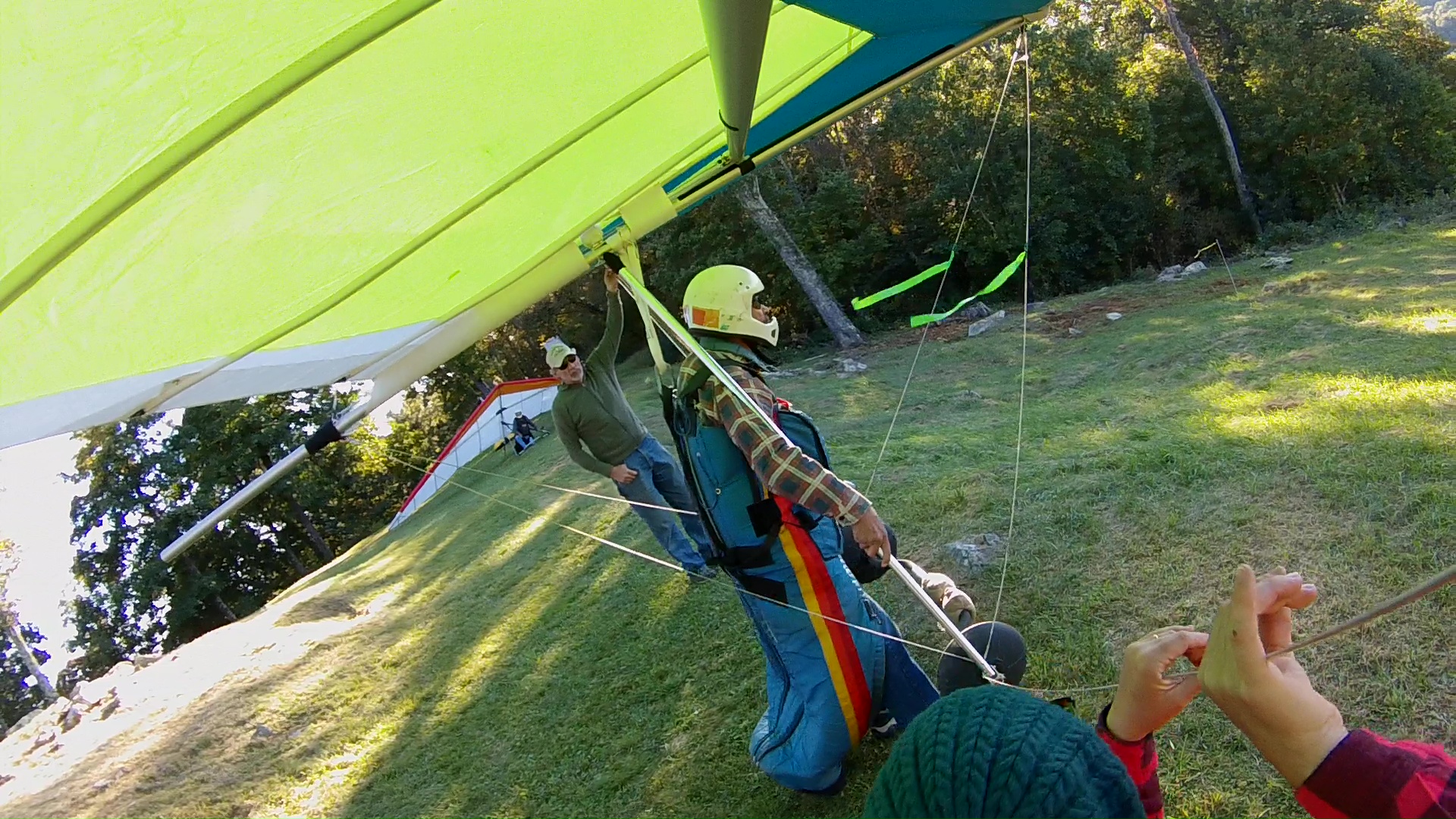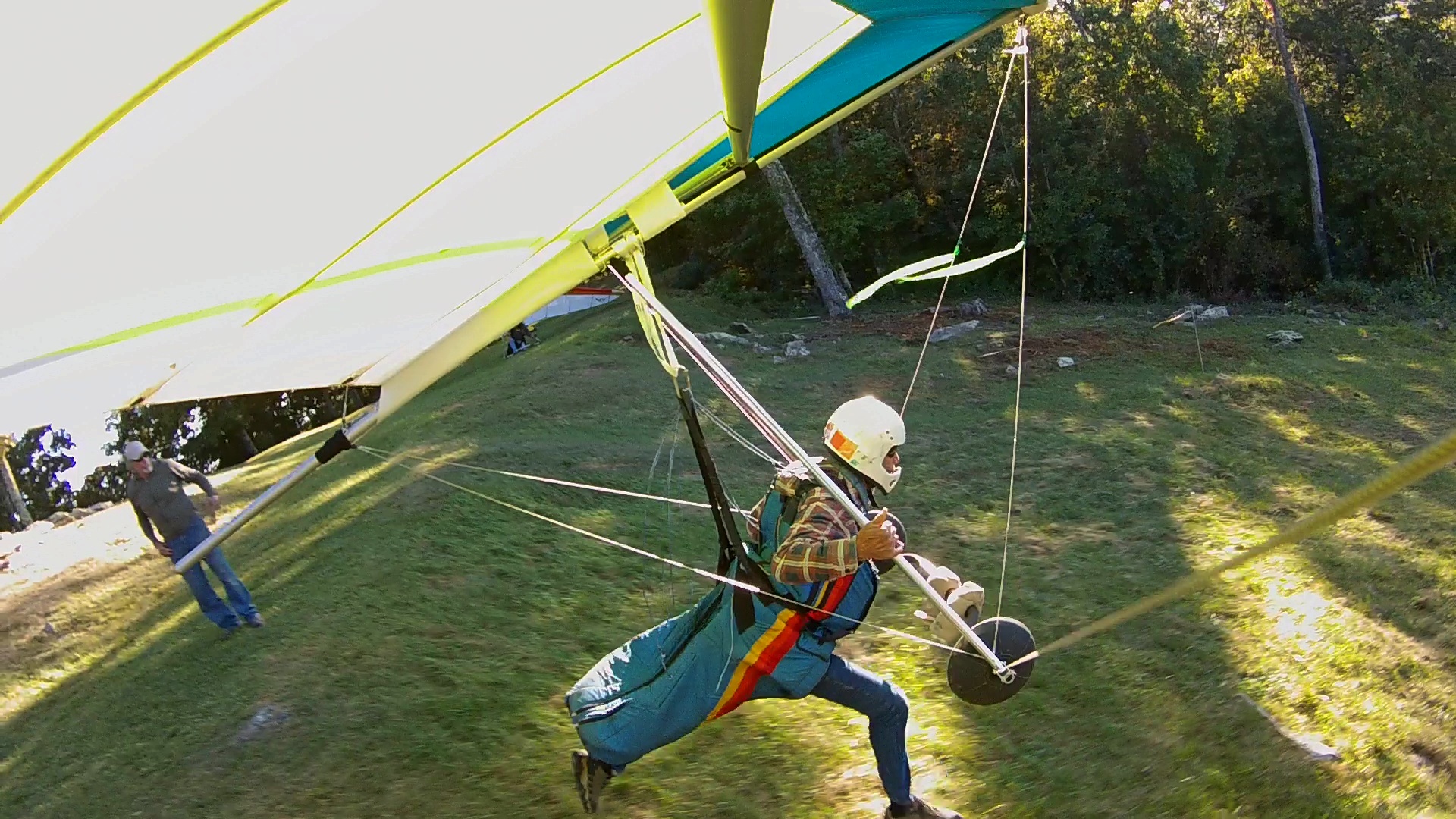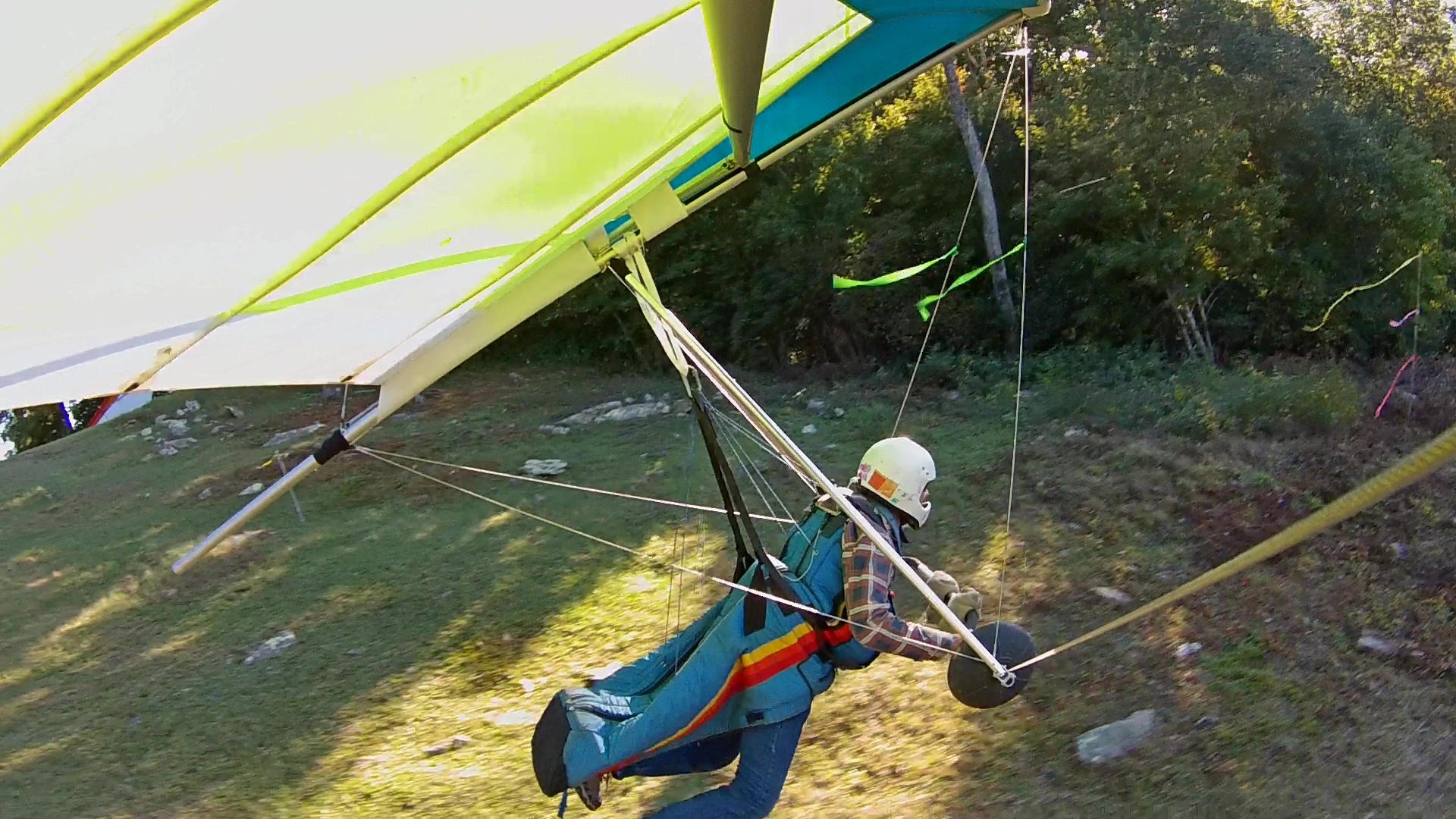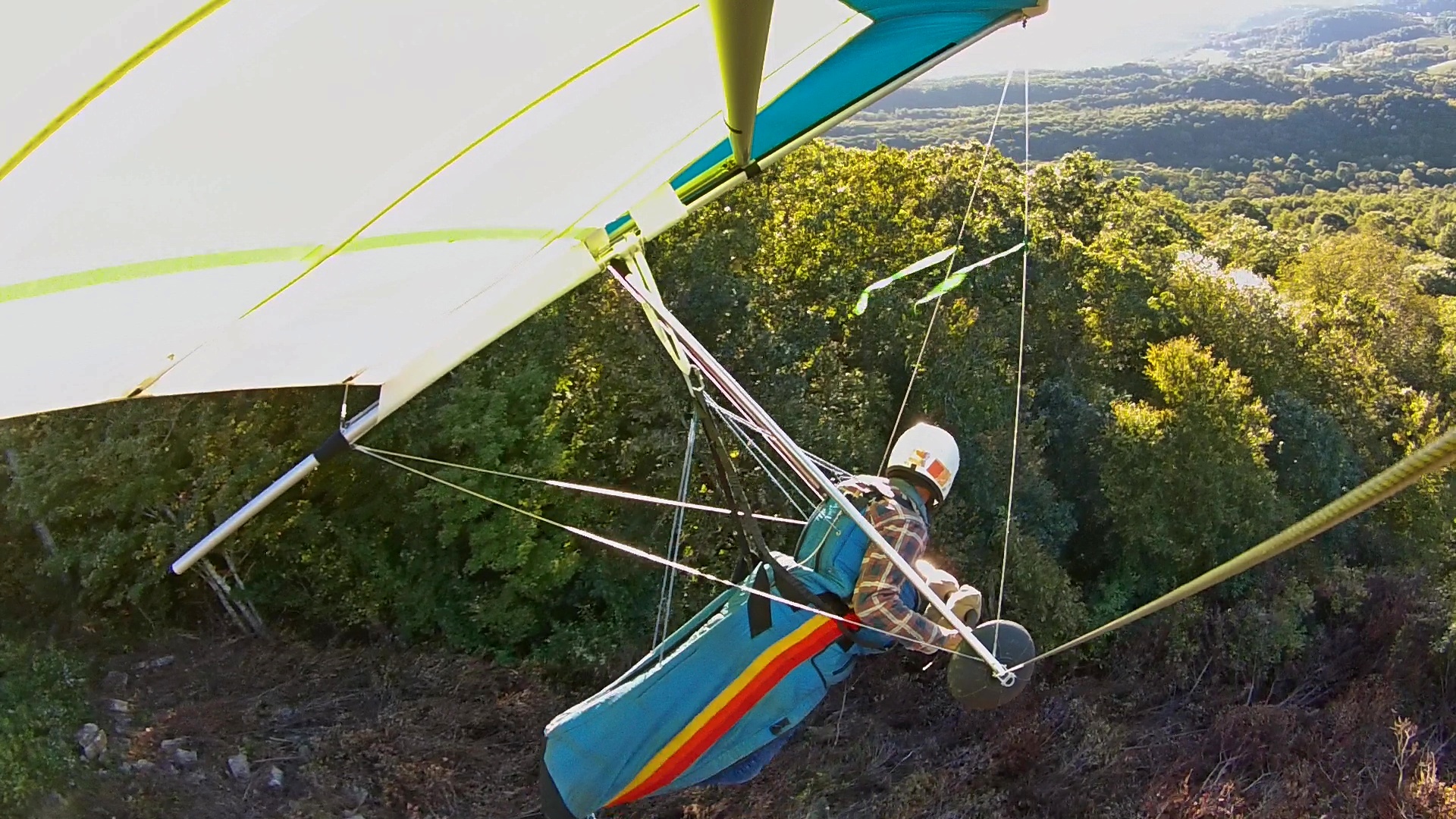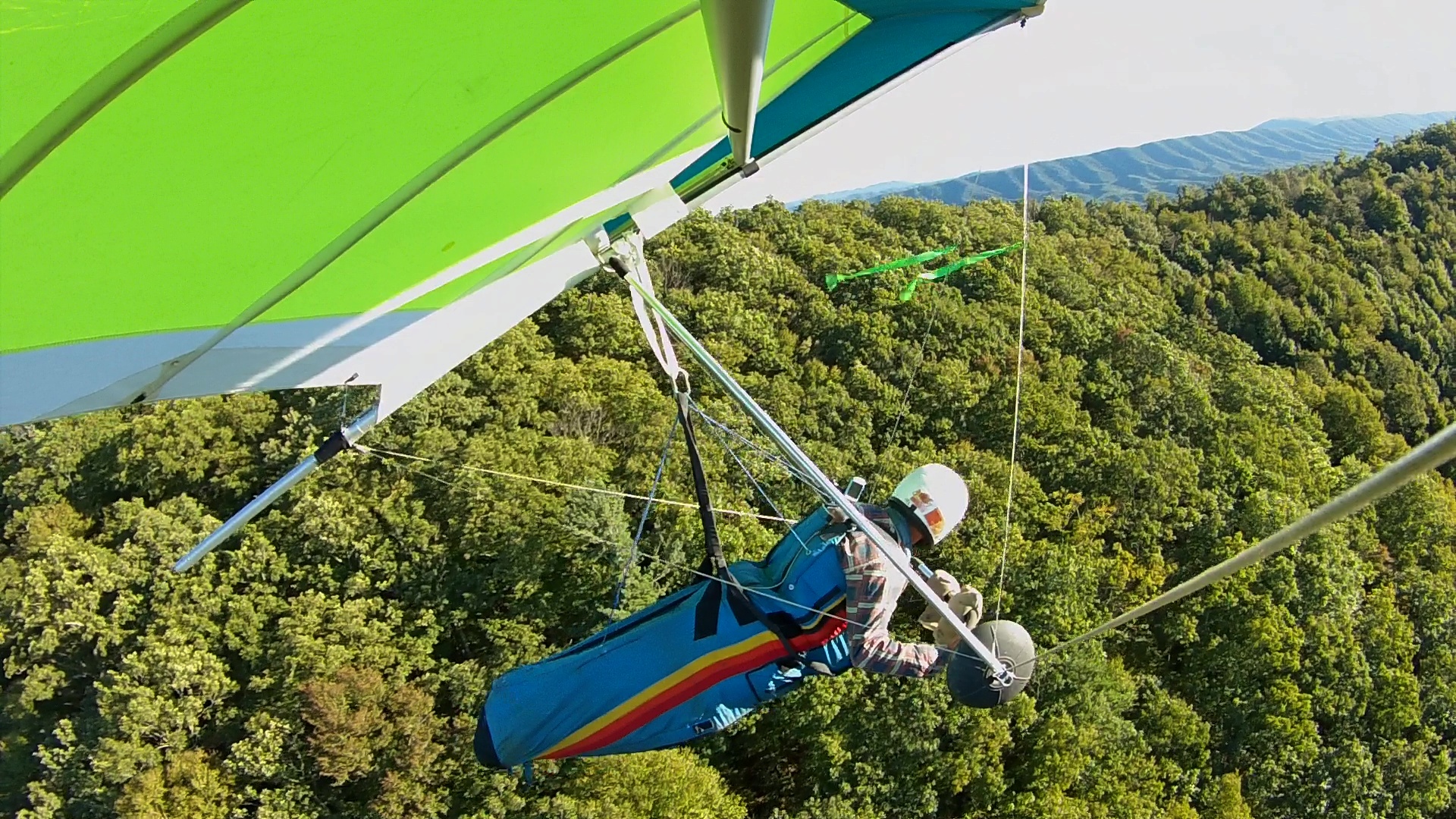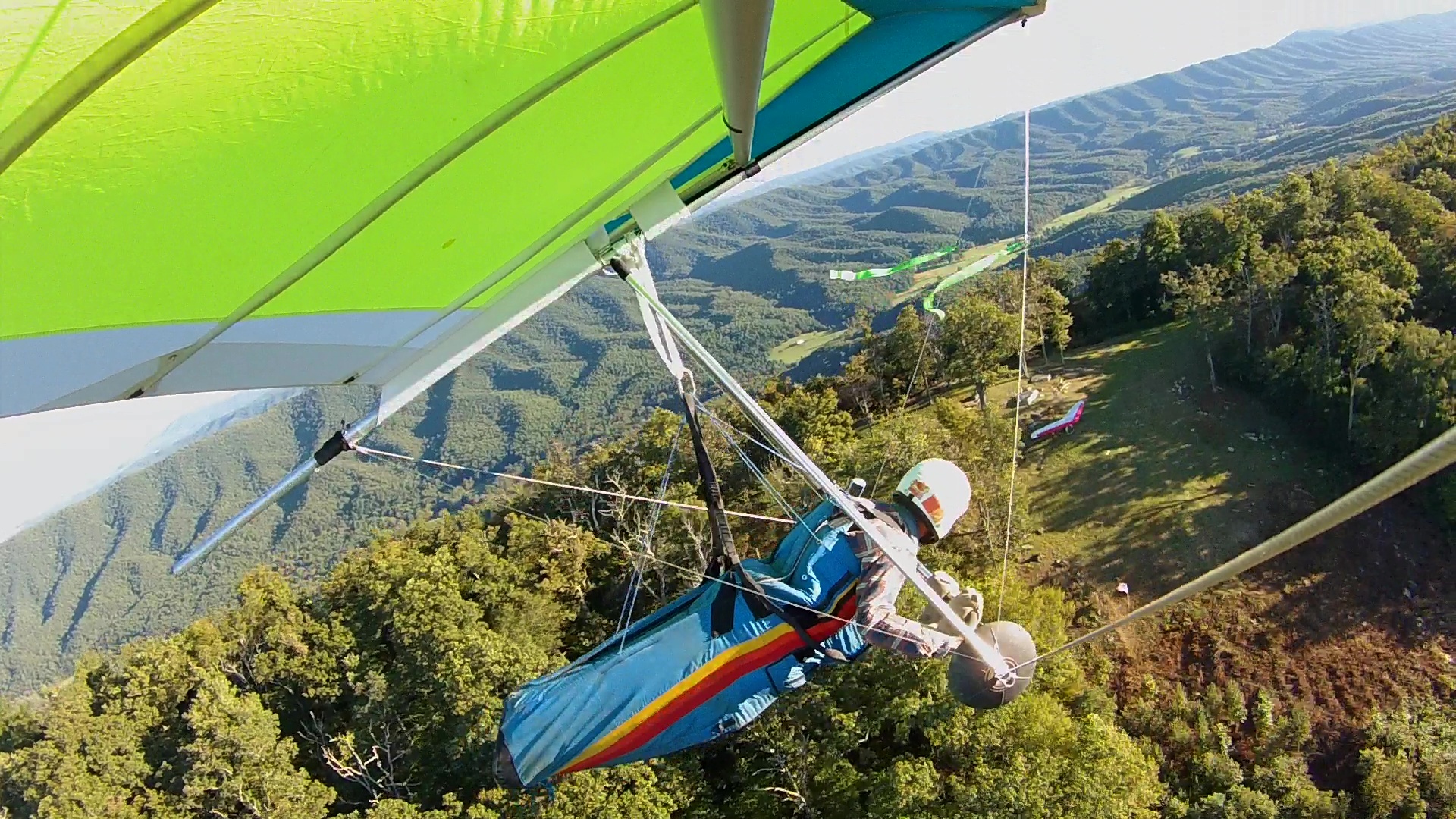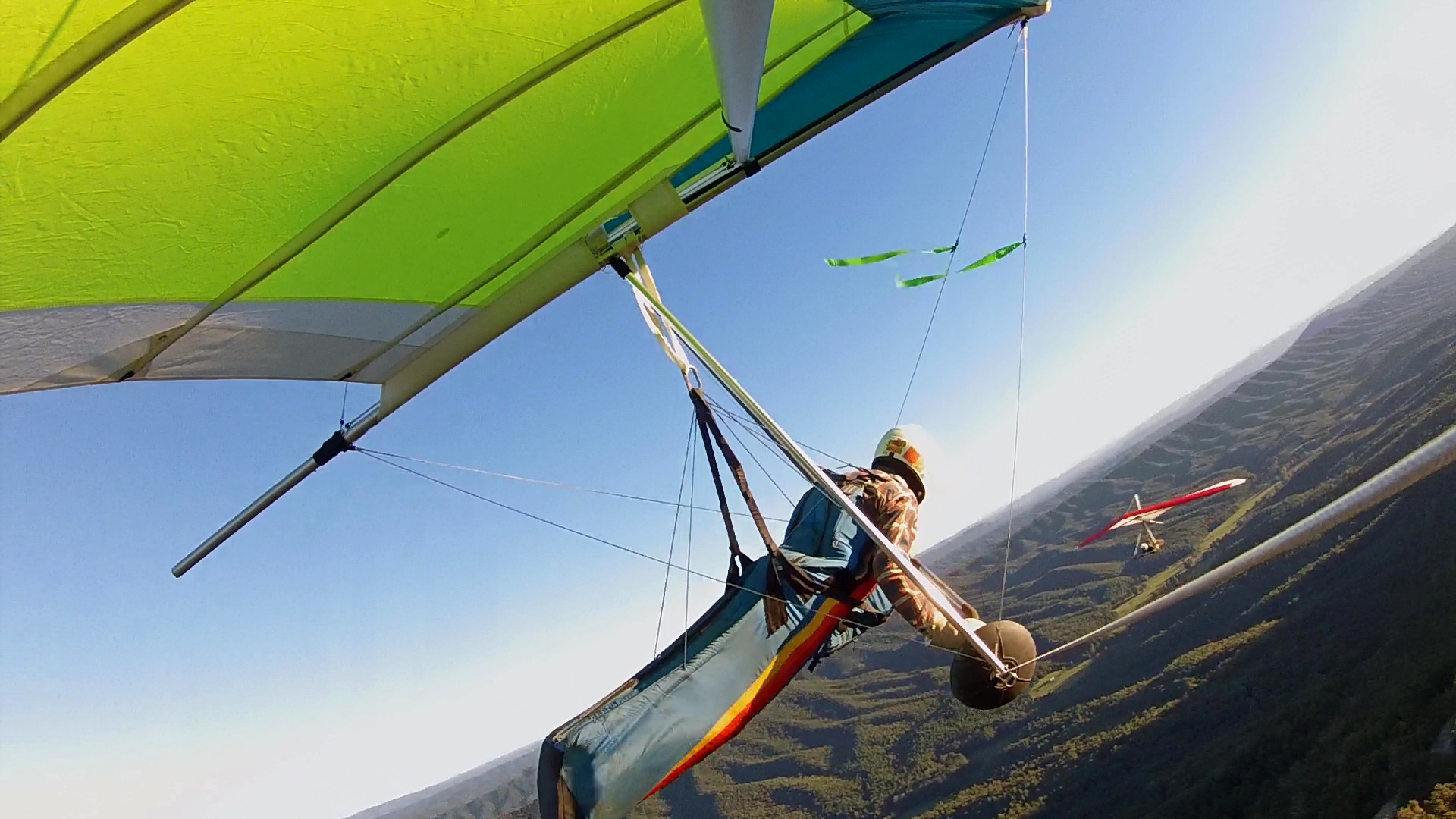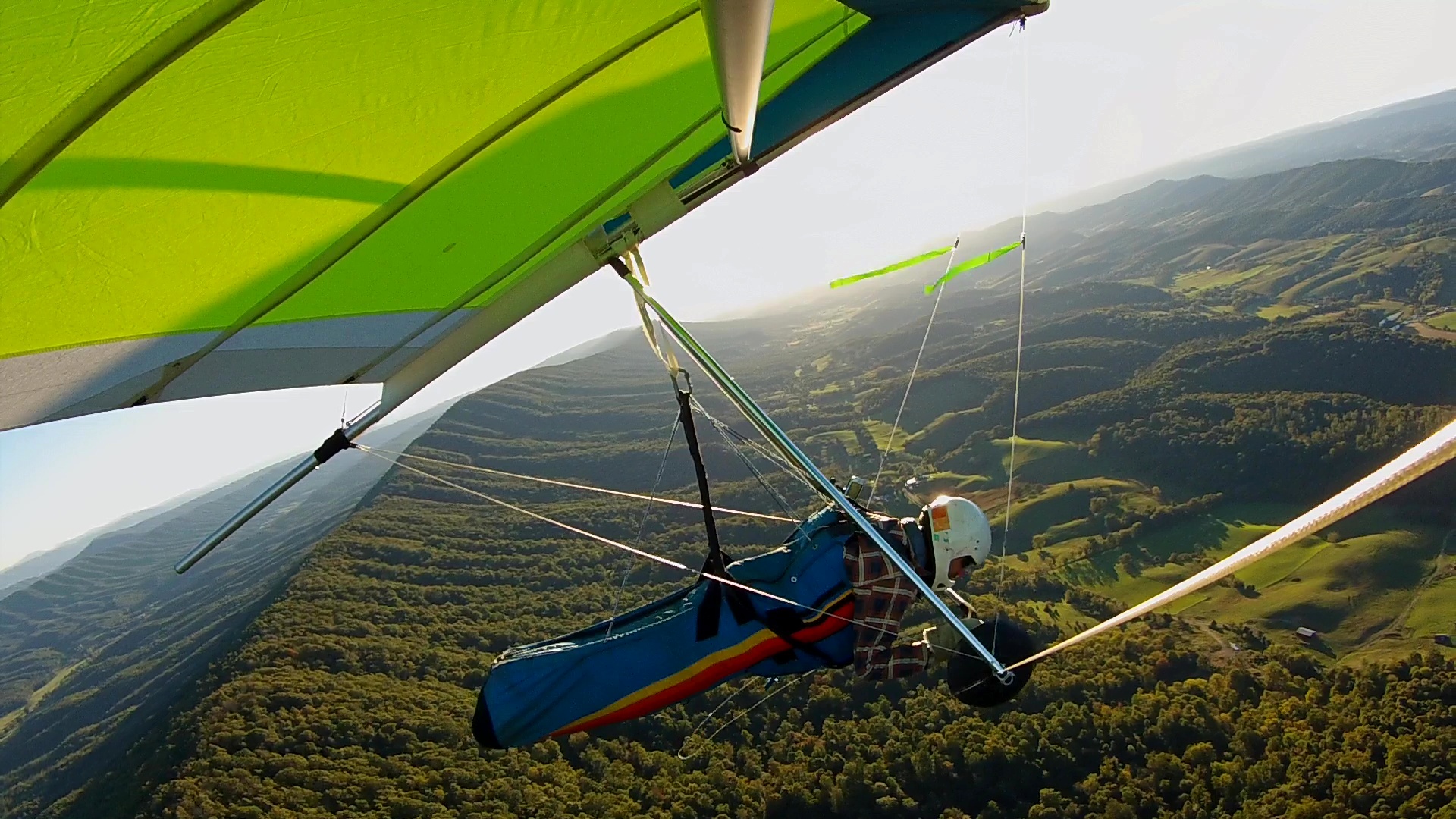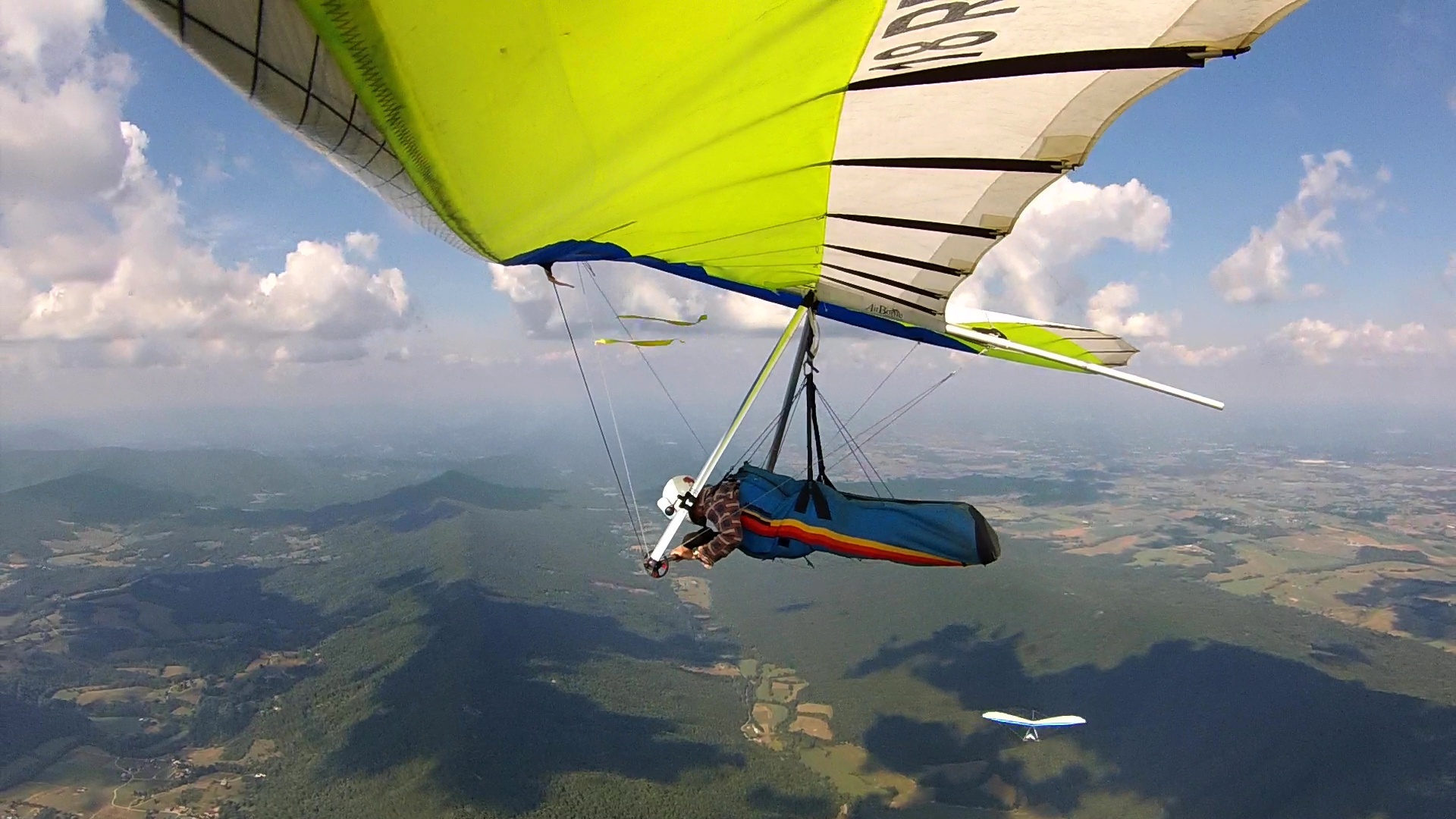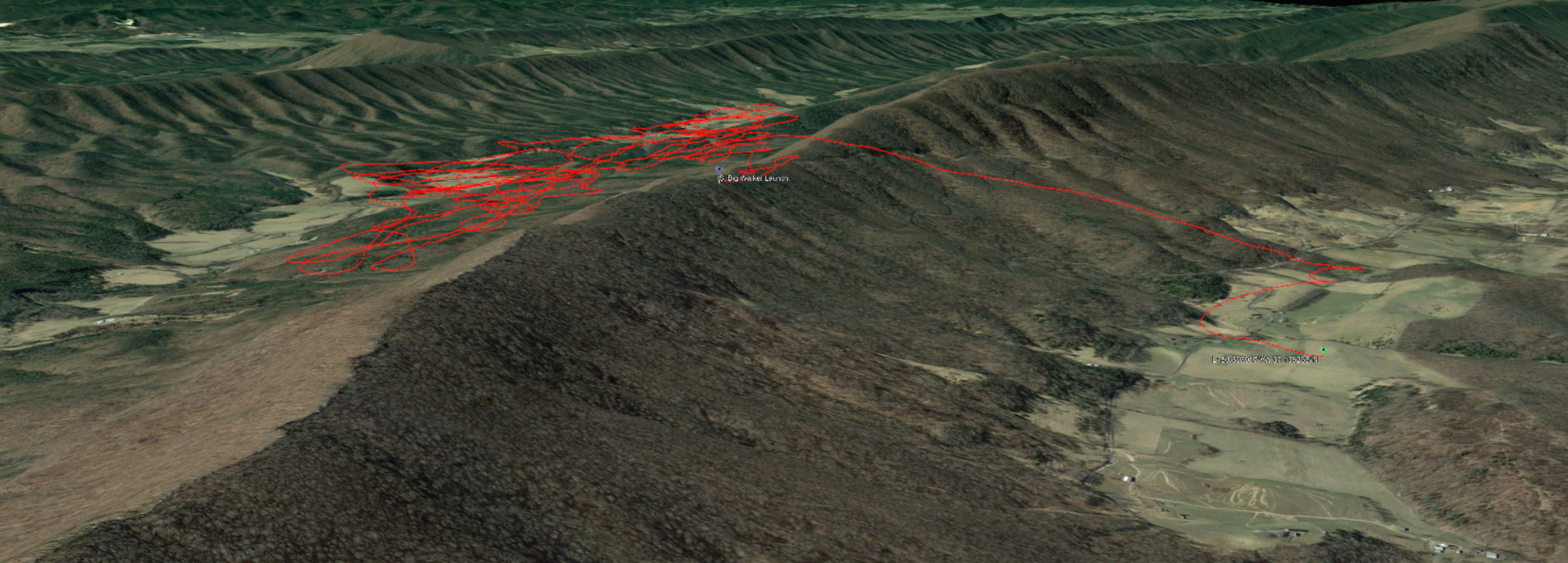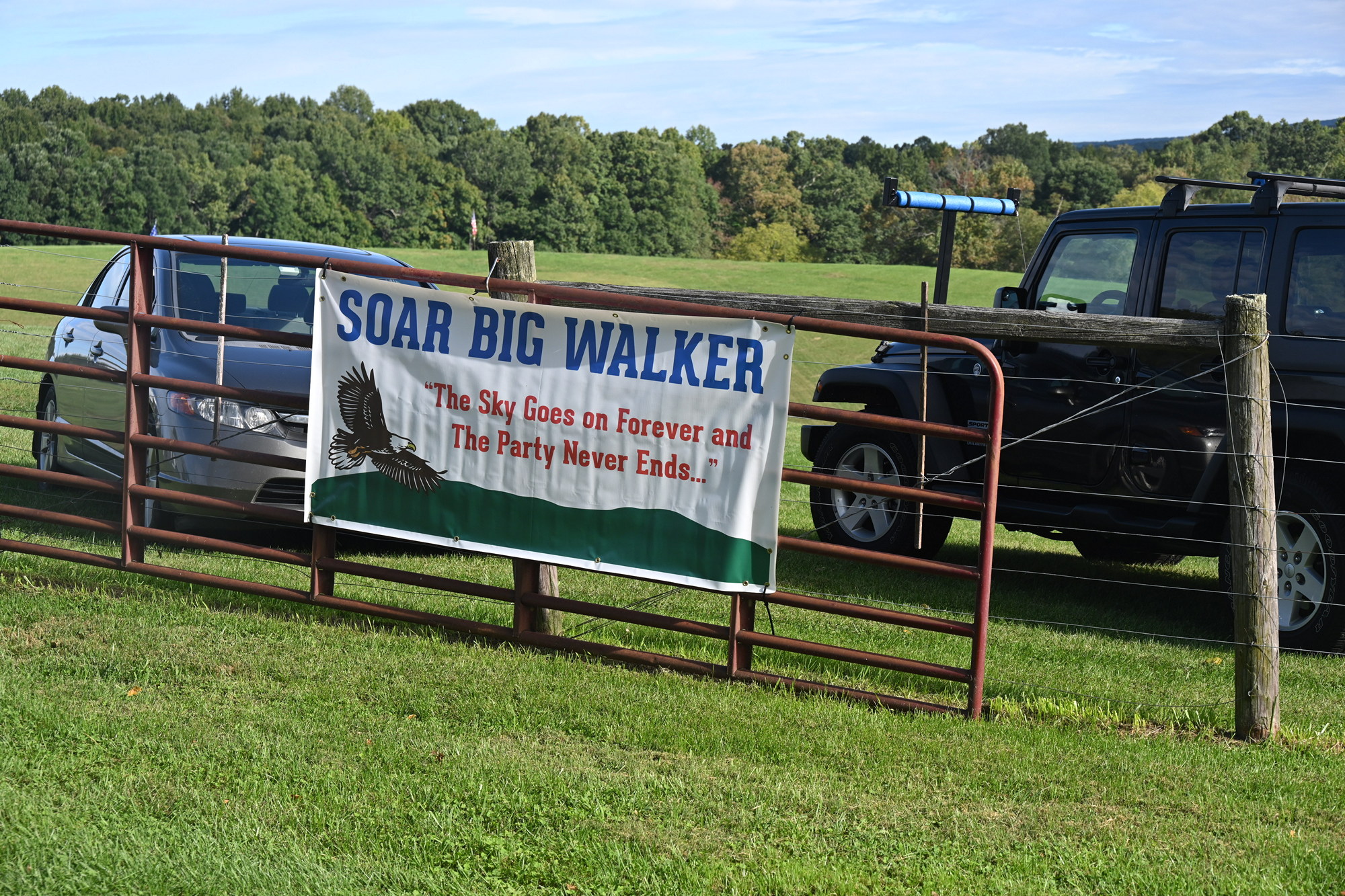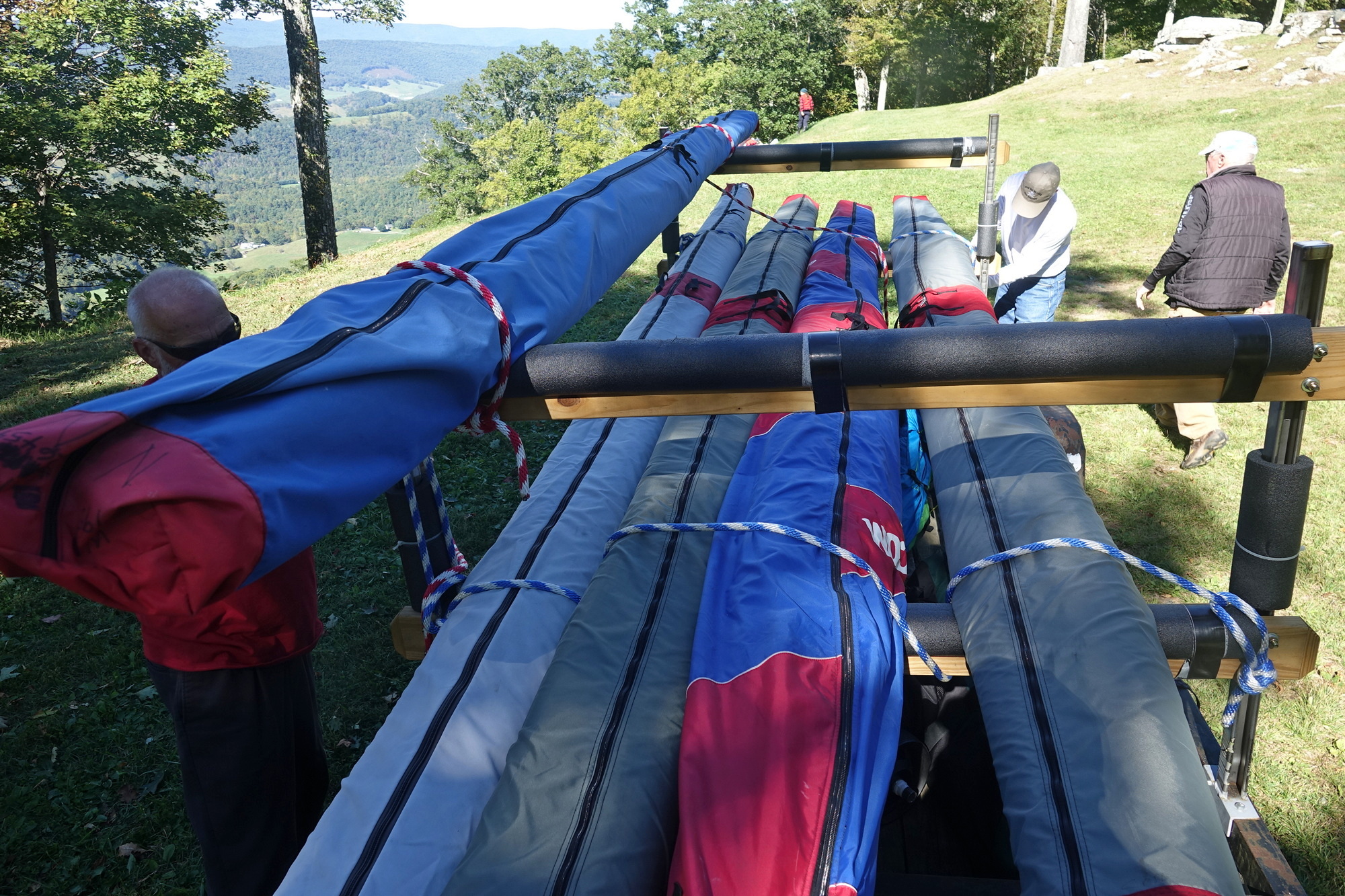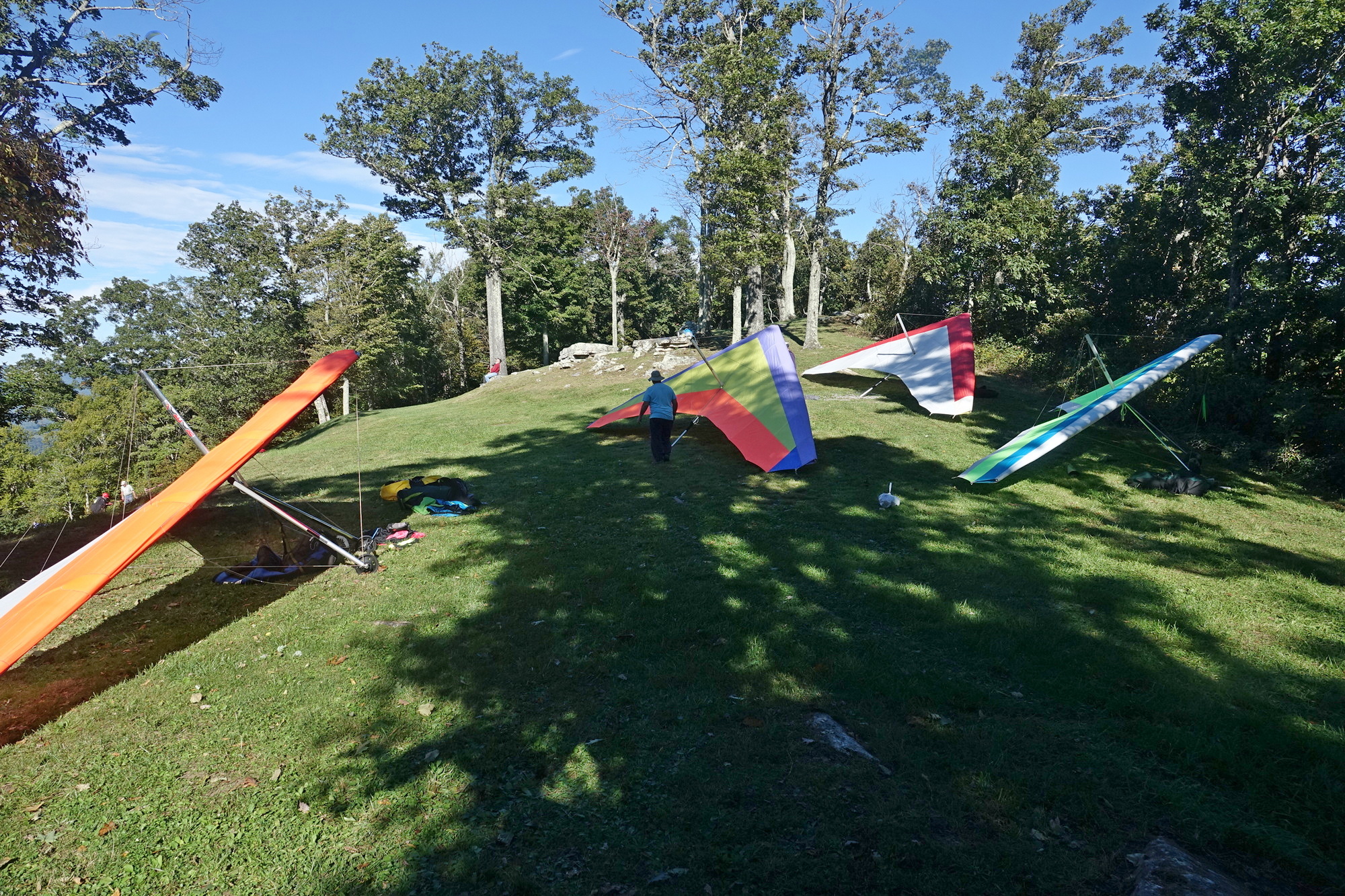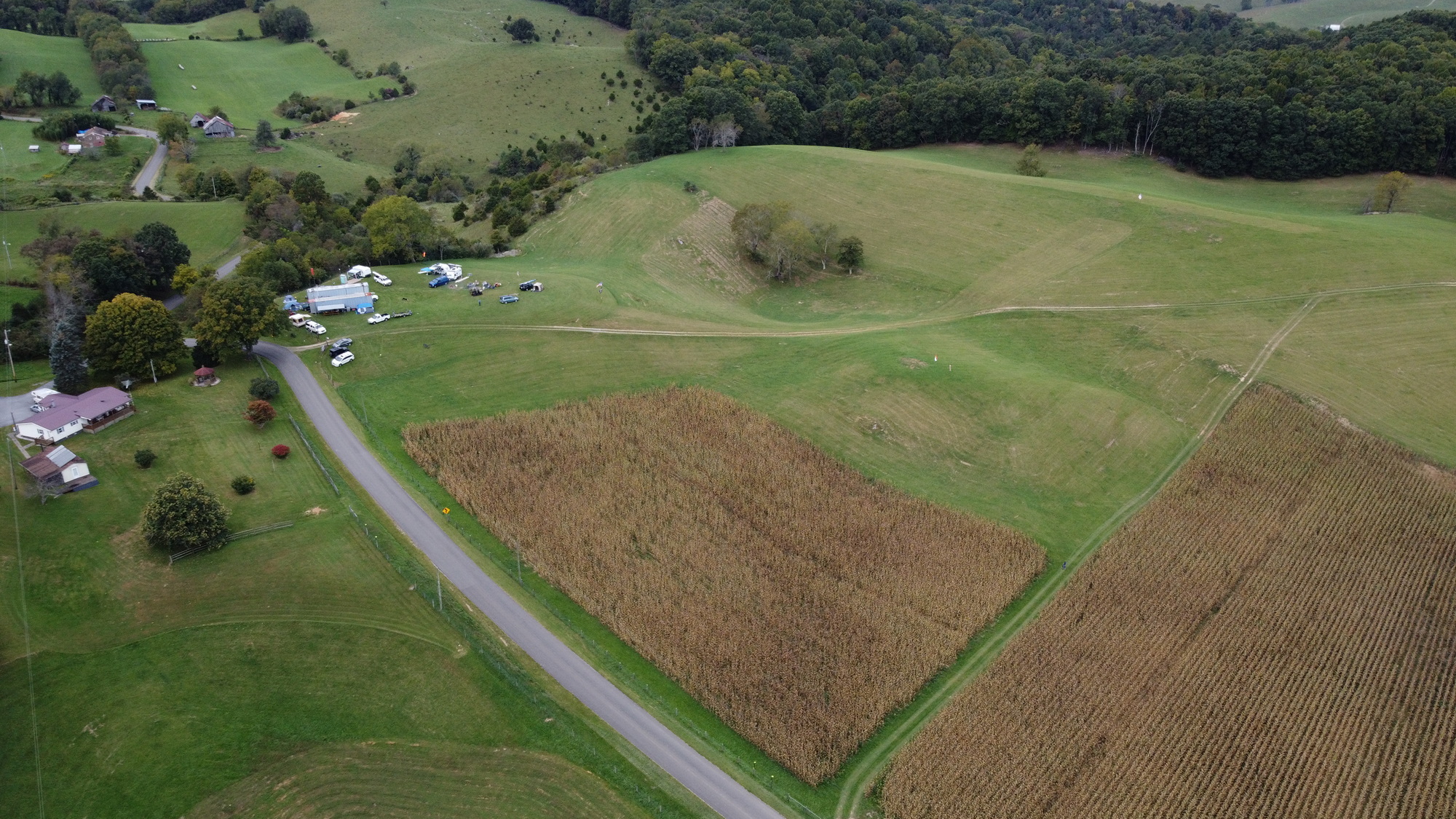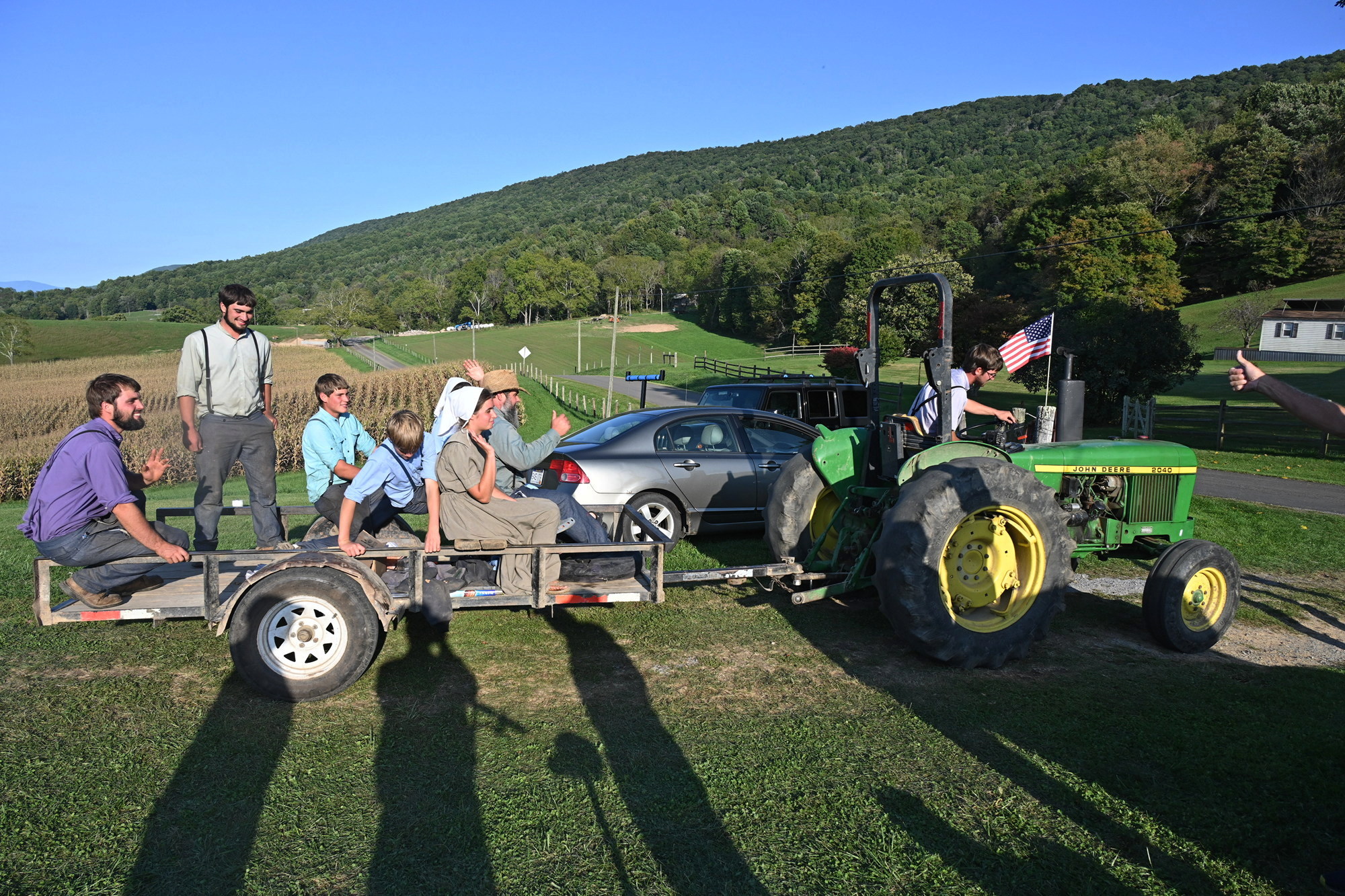Musings of an aging hang glider pilot
~ Friday, September 30, 2022 ~
(Sept 30, 2022) “Mama Walker” (Big Walker Mountain) is a fickle lady. One day she can take you to incredible heights, other days a hard smack down to earth. With Covid and other things in life, my visits to her have been rare in the last few years. Last weekend was the Big Walker Fly In, and I paid her a visit to see what she might offer me. At my age I am no longer interested in the often rock and roll rowdy thermals that can take you to the incredible heights (and sometimes severe pucker when coming into a turbulent LZ at the end of a flight). After over 40 years of flying, and a body that is slowing down, I am more than happy to experience the magic of stepping off a mountain again, but into gentle evening conditions. If one is lucky, a Wonder Wind will kick in as the sun is sinking - a gentle and widespread lifting of the last warm air as the valley below cools.
For younger and bolder pilots, mid-day thermals can be wondrous things - finding the center of one and turning tight, high banked circles can take you to great heights at 1000 or more ft/min. In a matter of minutes the mountain you launched from can seem to flatten as it recedes below you. But what goes up must go down, and where there is rapidly rising air, there must also be rapidly sinking air, often very close by. Flying out of one into the other can result in “going over the falls”, which is exactly what it sounds like, as you find your glider nose suddenly pointing at the ground (modern gliders will recover quickly). Or encountering turbulence that leaves you feeling weightless while you hear the sail being smacked down on the frame above you. Modern gliders are built to safely handle this, and it mostly comes down to how much you like riding in ‘rodeo air’, although in extreme conditions (most often in desert terrain, with high heating and dry air) gliders can be broken by severe tumbles (which is why we carry parachutes).
Thermals can take you to “cloudbase”, which is the altitude at which cumulus clouds are forming. When you see a sunny day with lots of puffy white clouds, those are cumulus. Many of them will have flat dark bottoms and tops with defined edges, like a head of cauliflower. Those are the tops of active thermals. The flat bottoms are all at the same altitude, which reflects the dewpoint of the rising air. Once you start getting close to the clouds, the terrain below matters very little, you are now flying cloud-to-cloud, all the while being careful not to get too close to that flat bottom. Bigger clouds mean stronger thermals, and if you get too close you can find yourself in powerful lift that you can’t get out of - soon to find yourself being rocked in the whiteout turbulence of a cloud with no way to know up from down. Usually you will eventually be spit out the side, colder, shaken, and hopefully wiser (I know people it has happened to, but I am not one of them).
On the best of days, once you get near cloudbase, you might see that your cloud is part of a line of clouds, leading off to the horizon - which is known as a “cloud street”. These almost never happen on days you have planned for them, but always on days you have something else you were supposed to do and no ground support. The temptation is strong - do you take a ride down the cloud street to unknown distances, or circle down to be responsible with your other obligations. Hint: responsibility does not always win :-) So you drift downwind, heading for the next cloud, and soon your normal LZ is too far away upwind to return to, and you are truly on your way. You might get “shot down” only a few miles on your way, leaving you wishing you’d been responsible. Or you might not land for hours and many miles away (Big Walker pilots have made many flights of 50 to 100 miles ‘over the back’ and into North Carolina). Eventually you will land, and now you have to find a way home. Before cell phones this may have meant knocking on a farm house door and asking to use their phone to make a long distance call. And who to call, when no one was expecting to suddenly be asked to spend the rest of their day (evening) driving to pick you up? Or maybe you have to resort to hitch hiking to get home, only to have to return the next day with a vehicle that can carry the glider you stashed in the corner of a field.
Over my years of flying I have touched clouds, and “cut the cord” as I drifted downwind, leaving the home site behind for parts unknown. I have experienced great joy and sheer terror - taking to heart the old pilot adage that it is better to be on the ground wishing you were in the air, than to be in the air wishing you were on the ground. There is magic about it that keeps one coming back - and it is indeed magic to hook yourself to a few pounds of Dacron and aluminum and step off a mountain - even if that magic is solidly grounded in physics. At my age I have gotten as high and gone as far as I will ever go, or indeed want to. Been there and done that. For a rusty old pilot even a “sled ride” down to the LZ in calm conditions is fine enough.
So last weekend there was one good flyable day, and many pilots had good flights before I got there. Some flew for hours, got respectable altitude gains (several thousand feet) and saw good portions of the 30 mile long ridge. That was all mid-day stuff, for the young-uns. I arrived mid afternoon to do a leisurely setup on the mountain, waiting to see what the evening would hold. As it neared 5PM the winds were settling, but it seemed the whole side of the mountain was “active” - leaves in the treetops lightly rustling wherever you looked. I’ve learned that sometimes, when you see that, even if the wind on launch is light, there can be sweet lift out in front of you.
Learning to fly a hang glider is not that hard, at least the mechanics of launching, landing and turning can be learned in a few weeks or months. It is learning about the air you are launching into that goes on for a lifetime. The wind you see coming into a launch is seldom enough information to determine if or when to launch. That gentle breeze blowing up the slope may actually be a “rotor” - a horizontal roll of air at the top of a mountain from wind coming behind the mountain and descending in front of you - a guaranteed rough and unhappy ride to the LZ, if you can make it that far. For launch slots cut in a forest, as are common in the East, a cross wind will usually turn and flow up the slot, regardless of the actual wind direction. What are the leaves down on the side of the mountain doing - are their silver (underside) faces visible to the left or right? Any soaring birds to watch? Do the buzzards have their wings stretched fully out (indicating milder conditions), or are the pulled in in more of a V-shape, indicating stronger/turbulent air. Which way are the clouds moving, what is the variation in timing and intensity of the wind you can feel, what time of day is it, what do you know about local conditions for that particular flying site? Should you expect katabatic flow (downslope wind caused by a cooling mountainside as the sun sinks) in the LZ? Air capable of sustaining flight beyond a “sled ride” - soaring air - is by definition turbulent. Wind coming into the side of a mountain has to rise to get over the mountain - which provides “ridge lift”. Uneven heating of the land causes rising columns of hot air called thermals. The puffy white clouds you see dotting the sky on a clear day are the tops of thermals - although you can also have thermals on clear days. Most commonly, we fly in some combination of ridge and thermal lift. So, while we require certain forms of turbulent air to stay aloft, our wings are large and light and can be easily overwhelmed - literally a leaf in the wind. The lifetime of learning goes into determining when to fly, and when to leave the wing safely folded. Even pilots launching 10 minutes apart can have entirely different flights.
Pilots can be like lemmings - all sitting on the mountaintop, eyeing one another - “looks good, you go first”. If someone flies and they end up in the LZ, everyone goes back to waiting as the hapless pilot is tearing down his glider below. But if that pilot gains altitude, there is a rush for everyone to get off the mountain as quickly as they can. I have a favorite memory where I was on the good side of that story. A mountain up in West Virginia with a party to go to afterwards. We all set up there for hours, watching the wind streamers barely move, hoping for something more to develop. Finally, as the afternoon wore on, I resolved to “take my sled ride like a man” so I could get on to the party and the cold beer. I waited until I saw the slightest puff of air coming in and launched. Surprisingly, my variometer (vertical speed indicator) gave me occasional chirps, meaning light rising air. I circled as slowly and as gently as I could to stay in the elusive lift. After what seemed like a long time I gained maybe 50 or 100 feet, and the chirping became more consistent (stronger lift). Eventually it “turned on” and I was at 1000 ft and still climbing - after a bit I topped out with an 1800 ft gain. As I circled in my lofty perch I watched the whole group of pilots left on the mountain rush to launch - and go straight to the LZ. Apparently I had lucked into one of the few thermals of the day. That I was on the good side of that story being such a memorable event tells you how few times I got to experience such a fortunate outcome. The beer that evening tasted even better than anticipated.
But now there were just three of us left on the mountain, and another pilot with many more years of experience than me decided to launch. He held on for 5 or 10 minutes at about launch altitude, but losing a few feet here and there, and finally heading to the LZ. But while I was watching his flight, it seemed the wind was getting slightly stronger, especially after he was on his way to the LZ. By the time he had landed it had definitely picked up. Maybe not quite a Wonder Wind (lift seemingly everywhere), but close to it.
I had a two step launch and turned out of the launch slot into lightly lifting air. Regardless of what you may have expected, the next couple of minutes after emerging from the end of the slot will determine much of what your flight will be like. On many sites you can only lose a couple of hundred feet of altitude, or less, before having to leave the mountain to safely reach the LZ. Finding lift and gaining altitude in those first minutes is critical to extended flight. Thermal cycling means pilots launching 5 minutes apart can find one above the mountain, and the other in the LZ. Once over the mountain you have altitude to lose before you need to head for the LZ, and that extra altitude can allow you to ride out lulls and lighter air.
My lightly lifting air was consistent enough that I was soon above the spine of the ridge. Once above the ridge top, compression effects make for more consistent lift, and I was able to begin searching out the stronger and more consistent areas of rising air. And also watch the last pilot on the mountain rush to launch to join me. Soon we were both above the ridge enjoying the evening air (after 5PM, with sunset just after 7). For 45 minutes we were able to enjoy gentle and fairly consistent rising air, mostly at 4 to 7 hundred feet above takeoff. Some parts of the ridge had more consistent lift than others, and we both soon found those. No adrenaline pumping high banked thermal turns to rocket us to lofty altitudes, just the gentlest of low banked turns at the lower end of the speed range to milk every foot of altitude possible from the light air.
For this old pilot, to once again see the world from above the mountain was thrill enough. The sinking sun cast shadows on the lush landscape below, highlighting every feature of the toy landscape. I know my days in this sport are limited, and that is ok, I’ve known over 40 years of doing what mankind has dreamed of for thousands of years. When I am no longer flying, I still will not lose the sky - being able to look up and see and know things most people never will.
As the sun sank lower, the lift became lighter and we slowly lost altitude. I left the mountain while still above it to have plenty of time to set up my landing - I was a bit nervous about my rusty landing skills in a challenging LZ. But I ended up being completely happy about the landing approach and touching down just where I had planned to. The last second, the landing flare, was not one of my proudest most graceful ones, but definitely “good enough”.
This was during a Fly In, so many pilots had had good flights that day, and the beer and tales around the campfire that night were especially satisfying.
Ready to launch, evaluating the conditions. Are the streamers pointing straight up the slot? Are the leaves on the edges of the slot rustling about the same amount? Is there any other traffic? What is happening in the tree tops below launch - is that a thermal heading my way? Does the wing feel balanced and stable? Assistants stand read to grab wing wires if a gust gets me too far out of balance. Before taking that first step is the last time I have full control over decisions - from then until landing.
It was an easy launch, just a couple of steps and I was airborne.
Between liftoff and the end of the launch slot is a busy period - transitioning hands from the uprights to the basetube and getting legs back into the harness. You want to be in full flying posture when emerging from the end of the slot.
Coming out of the end of the slot you need to be prepared for anything. Maybe the wind was more cross than you realized, or perhaps there is a strong “lift band” out beyond the trees. A strong lift band has caught many an unwary new pilot, sometimes with disastrous consequences (the unexpected lift, hitting the nose of the glider first, tilts the glider up into a stalled position - before the pilot can recover the glider has stall-turned back into the mountain). Today such an event is very unlikely, but survival in this sport means continually expecting the unexpected.
First pass on the ridge. This is starting to look good. Maybe a few feet of gain already, and coming to a favorable spot. The ridge has a slight backwards bend on my left, just as the ridge height decreases. These often combine to provide a small but predictable lift area. Turning in this lift will minimize the normal altitude loss that comes from a turn, and possibly even add a bit.
Above the ridge now, things are looking much better. Still not assured by any means, but now a bit of altitude to work with, and the advantage of being able to get more into the compressed lift of the air going over the ridge top. My flying partner is liking what he is seeing, and rapidly getting ready to join me.
Now we are both settled into soaring flight with enough altitude to work with. Even with only 2 of us on the ridge we have to be constantly aware of each other’s location.
This is a favorite time of day to fly - smooth gentle air, and the settling sun casts long shadows. Every bump, sinkhole and ridge is outlined in shadow.
This is a flight from a few years back, flying earlier in the day. This is an altitude gain of around 3000 ft. The mountains below are starting to appear flatter. This is not quite at cloudbase, but you can look at the flat bottoms of the clouds and see that I am not that far from it. Depending on other things as well, this can be where you start to have serious thoughts of leaving the home site for a flight to an unknown destination. My highest ever altitude gain was a little over 6000 ft (respectable, but not remarkable in the East - routine in the drier West). I was nearing the bottom of a fairly large cloud, being sure I stayed close to the edge so I could make a run for it. As the lift started getting stronger, I did just that and got out from under the cloud altogether. It would have been quite easy for it to have sucked me up and spit me out at some later time, cold and scared at the very least, if not worse. It was thrilling, but also scary and lonely - being at least a mile away from anything in any direction, and my lifeline being just a few pounds of aluminum and Dacron.
A GPS track of my most recent flight - nothing dramatic, just “taking the air” on a gentle evening
A sign we put out for flying events
With lots of pilots at a Fly In, the owner modified a trailer to carry loads of gliders to the top, thus alleviating vehicle congestion on the mountain top and retrieval hassles.
Getting set up for my evening flight. My glider is on the right.
The LZ and Fly In camping area (drone photo). The camping area is on the left, and the mown strips on the side and top of the hill on the right the designated landing areas. This was the day after we flew, with no more flying potential in the forecast, so many people had already left.
An Amish family owns the LZ (the corn is theirs) and they enjoy hosting the flying activities. Here they are leaving after a nice visit.
